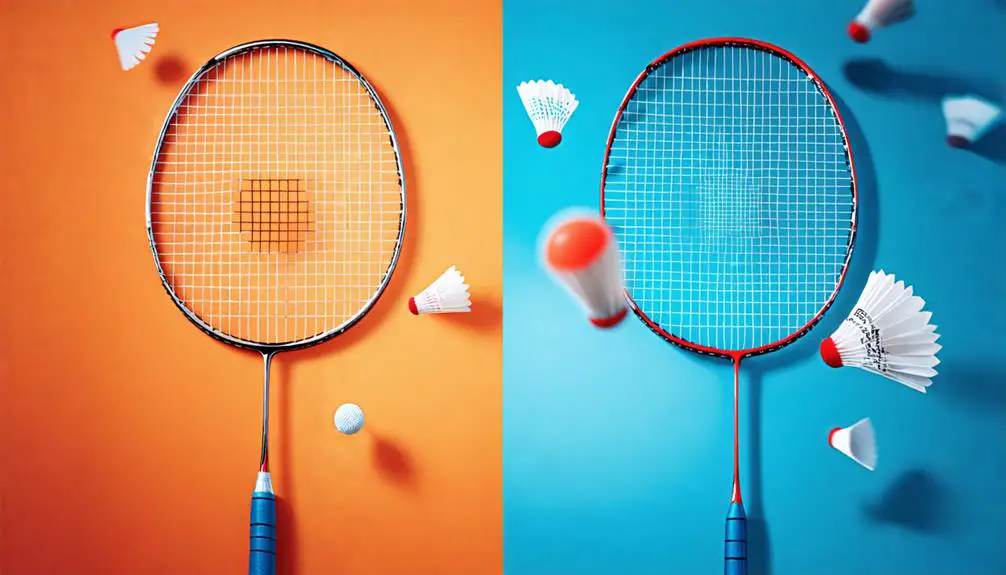When choosing between aluminium and graphite badminton rackets, consider your skill level and playing style. Aluminium rackets are heavier but durable and affordable, making them great for beginners. They offer good control and stability, though you might feel fatigued over long matches. Graphite rackets are lighter, enabling quicker swings and better maneuverability, perfect for advanced players who focus on power and precision. However, they're more expensive and can be prone to damage. Balancing weight, durability, and price is key to your decision. To make the best choice, you'll want to look deeper into these factors.
Overview of Materials
Choosing between aluminium and graphite for your badminton racket involves understanding the properties of each material. Aluminium is a lightweight, sturdy option that offers good control and stability. It's often chosen for beginner rackets because it's affordable and can withstand the rigors of learning. With its robust construction, an aluminium racket can handle accidental drops and impacts, making it a safer choice for those just starting out. You won't have to worry much about damaging the frame, allowing you to focus on improving your skills.
On the other hand, graphite is known for its exceptional strength-to-weight ratio. It's lighter than aluminium, which can lead to faster swings and improved maneuverability. If you're looking to enhance your performance, a graphite racket may be the way to go. However, it is crucial to understand that while graphite provides a more responsive feel and better shock absorption, it can be more vulnerable to severe impacts. This could potentially raise concerns about safety if you're not careful.
Ultimately, both materials have their pros and cons. If you're focused on safety during your learning phase, aluminium might be the safer bet. But if you're more experienced and want to push your game to the next level, investing in a graphite racket could enhance your play. Just remember to weigh your options carefully to find the best fit for your playing style and safety needs.
Durability Comparison
When you're choosing between aluminium and graphite badminton rackets, durability is a key factor to take into account. Aluminium often offers more material strength, while graphite provides better impact resistance. Understanding how these materials perform under pressure can help you make an informed decision.
Material Strength Analysis
In the world of badminton rackets, the durability of materials like aluminium and graphite plays an essential role in performance and longevity. When you're choosing a racket, understanding the strength of these materials can help you make a safer choice.
Aluminium rackets are generally known for their toughness. They can withstand rough handling and are less prone to breaking under pressure, which is reassuring for beginners or casual players. However, they can be heavier, which might lead to fatigue during long matches.
On the other hand, graphite rackets are lighter and often provide better maneuverability. Their construction allows for excellent power and precision, but they can be more susceptible to damage from mishandling or extreme impact. If you're someone who plays frequently and at a high level, investing in a quality graphite racket could be beneficial, as they're designed for peak performance.
Ultimately, your choice should balance weight, strength, and your playing style. Always consider how the durability of the material affects not just your racket's performance but also your safety during play. Choosing the right racket can enhance your experience and help you stay injury-free.
Impact Resistance Factors
Considering the demands of intense gameplay, impact resistance is a crucial factor in the durability of badminton rackets made from aluminium and graphite. When you're smashing the shuttlecock, you want a racket that can withstand those intense moments without breaking or bending.
Here's a quick comparison of impact resistance factors for both materials:
- Aluminium: Known for its sturdiness, aluminium rackets can absorb shocks well, making them a durable choice for beginners. However, they may not perform as effectively over time, especially with frequent high-impact hits.
- Graphite: Graphite rackets are lighter and offer excellent flexibility, providing better shock absorption. They tend to maintain their integrity longer under stress but can crack if subjected to extreme impacts.
- User Experience: Consider your playing style. If you're a power hitter, a graphite racket might be more suitable. If you're just starting, an aluminium racket can handle the wear and tear of your developing skills.
Ultimately, selecting the right racket based on impact resistance can enhance your safety and performance on the court, ensuring you enjoy every game while minimizing the risk of equipment failure.
Weight and Handling
Choosing between an aluminium and graphite badminton racket largely boils down to weight and handling. When you pick up a racket, the weight can considerably affect your game. Aluminium rackets are generally heavier, which may benefit some players by providing stability and a solid feel during hits. However, the extra weight can lead to fatigue, especially during long matches or practice sessions.
On the other hand, graphite rackets are much lighter, allowing for quicker swings and better maneuverability. This can enhance your reaction time, making it easier to respond to your opponent's shots. If you're concerned about maintaining control and ensuring safe swings, a lighter racket can help reduce the risk of mishits or awkward swings that might lead to injury.
Handling is another vital aspect to take into account. With a lighter racket, you'll find it easier to perform intricate shots and quick movements. This agility can be particularly beneficial in fast-paced games. However, some players prefer the sturdiness that comes with the heft of an aluminium racket, feeling more secure in their shots.
Ultimately, the choice between aluminium and graphite comes down to personal preference. If you're looking for a racket that minimizes strain on your wrist and shoulder, graphite might be the way to go. But if you value robustness and stability, you might lean towards aluminium. The best racket is one that feels right in your hands, allowing you to play comfortably and safely.
Price and Affordability
When you're choosing between aluminium and graphite badminton rackets, the initial cost can vary greatly. It's important to reflect not just the upfront price, but also the long-term value and any maintenance or replacement costs you'll face down the line. We'll break down these factors so you can make a smart investment.
Initial Cost Comparison
Although many players prioritize performance, the initial cost of a badminton racket can greatly influence your decision between aluminium and graphite options. When you're on a budget, understanding these costs can help you make an informed choice without compromising safety and enjoyment on the court.
Here are three key points to contemplate regarding initial costs:
- Aluminium rackets: Generally, these are more affordable, often ranging from $15 to $50. They're perfect for beginners or casual players who want a reliable option without breaking the bank.
- Graphite rackets: These tend to be pricier, typically costing between $50 to $200. They offer enhanced performance and durability, making them a worthwhile investment for serious players.
- Durability vs. Cost: While aluminium rackets may save you money upfront, they might not last as long as graphite options, which could affect your overall budget in the long run.
Long-term Value Assessment
While price is an important factor, evaluating the long-term value of your badminton racket can greatly impact your overall experience and finances. When you consider the initial cost of aluminium and graphite rackets, it's vital to think beyond just your upfront investment. Graphite rackets often come with a higher price tag but tend to offer better performance and durability over time. This means fewer replacements and a more satisfying playing experience.
On the other hand, aluminium rackets are generally more affordable, making them appealing if you're on a tight budget. However, they may not hold up as well under intense play, potentially leading you to buy a new racket sooner than expected. Weighing these options helps you understand the true cost of ownership.
In the long run, investing in a quality graphite racket could save you money and enhance your safety on the court. A well-constructed racket can minimize the risk of injury by providing better control and stability during play. Ultimately, choosing the right racket based on its long-term value will benefit both your finances and your playing experience.
Maintenance and Replacement Costs
Over time, understanding the maintenance and replacement costs of badminton rackets can help you make a more informed decision. When you're considering safety and performance, knowing these costs can save you money in the long run.
Here are three key points to think about:
- String Replacement: Regular play can wear out your strings quickly. Depending on the type you choose, replacing them can cost between $10 – $30. This is essential for maintaining safety during play.
- Grip Replacement: A comfortable grip is important for preventing injuries. Replacing it might set you back around $5 – $15. A secure grip enhances your control and reduces the risk of accidents on the court.
- Racket Replacement: If your racket sustains damage or wear beyond repair, you'll need to replace it. Aluminium rackets tend to be less costly, ranging from $20 – $50, while graphite can go from $50 to over $150. Choosing wisely here can affect not just your budget, but your safety as well.
Being aware of these costs guarantees you keep your equipment in top condition, allowing for a safer and more enjoyable badminton experience.
Performance Analysis
When comparing the performance of aluminium and graphite badminton rackets, it's evident that each material offers distinct advantages depending on your playing style. If you're a beginner or casual player, you might find that aluminium rackets provide a solid and dependable option. They're generally heavier, which can help with stability and control, allowing you to develop your skills without worrying about the racket being too light or flimsy.
On the other hand, if you're more advanced or competitive, you may prefer graphite rackets. These are lighter and offer greater power and speed, making it easier to execute quick, powerful shots. The stiffness of graphite also provides better energy transfer, which can lead to improved shot accuracy and responsiveness. However, this lightweight nature means you'll need to have a good grip and control to avoid mishits.
Safety is always a priority in sports, and both types of rackets are designed with that in mind. Aluminium rackets are generally more durable and resistant to damage from accidental impacts, while graphite rackets, though more fragile, are engineered to handle high-impact play. It's crucial to reflect on how you play and what feels comfortable in your hands, as using the right racket can not only enhance your performance but also reduce the risk of injury. Ultimately, understanding the performance characteristics of each material will help you make an informed decision tailored to your needs.
Suitability for Players
How do you choose the right racket for your playing style? When it comes to selecting a badminton racket, both aluminium and graphite options have unique features that cater to different players. You'll want to take into account your skill level, playing style, and comfort while making sure you stay safe during gameplay.
Here are three key factors to help you decide:
- Skill Level: If you're a beginner, an aluminium racket might be more suitable. They're generally heavier, providing stability and control, which can help you develop your skills. On the other hand, if you're an advanced player, a graphite racket's lightweight nature can enhance your speed and maneuverability.
- Playing Style: Reflect on how you play. If you favor power shots, a graphite racket can give you the advantage of quicker swings. For those who prefer a more defensive and controlled style, the sturdiness of aluminium can be beneficial.
- Comfort and Safety: Always prioritize comfort to avoid injuries. Make sure the grip size is appropriate for your hand, and take into account the racket's balance. An ill-fitted racket can lead to strains or discomfort, which you definitely want to avoid.
Ultimately, choosing the right racket is about finding what feels best for you. By taking these factors into account, you'll make sure a safer and more enjoyable playing experience.
Frequently Asked Questions
Which Material Is More Environmentally Friendly, Aluminium or Graphite?
When considering which material is more environmentally friendly, you should look at their entire lifecycle. Aluminium is often recyclable, which helps reduce waste, but the mining process can be harmful. Graphite, on the other hand, has a lighter footprint during production, but its extraction can also impact ecosystems. Ultimately, you'll want to weigh these factors based on your values and priorities, ensuring you choose a material that aligns with your commitment to the environment.
Can I Restring Aluminium Rackets Like Graphite Ones?
Yes, you can restring aluminium rackets just like graphite ones. However, you should be careful with the tension. Aluminium frames might not handle high tensions as well, which could lead to deformation or damage. It's best to stick to manufacturer recommendations for string tension. Always guarantee you're using the right tools and techniques to avoid injury. So, take your time and enjoy the process of maintaining your racket safely!
Do Professional Players Use Aluminium or Graphite Rackets?
When it comes to professional players, they typically favor graphite rackets due to their lightweight nature and enhanced performance. You'll find that these rackets provide better control and power, which are essential in high-stakes matches. While some players might use aluminium for practice or recreational play, it's less common at professional levels. If you're looking to improve your game, consider investing in a quality graphite racket for best results and safety.
How Does Temperature Affect Aluminium and Graphite Rackets?
Temperature can greatly affect the performance and durability of sports equipment. If you're using a racket in extreme heat, it may become more flexible and less stable, impacting your control. In cold conditions, materials can become brittle, increasing the risk of breakage during intense play. Always check your gear before playing in varying temperatures to make certain it's safe and reliable. Keeping your equipment at room temperature can help maintain its integrity.
Are There Specific Brands Known for Aluminium or Graphite Rackets?
Did you know that around 70% of players prefer graphite rackets for their lightweight feel and power? When you're choosing between brands, stick to well-known names like Yonex or Wilson for graphite, as they prioritize safety and performance. For aluminium, look at brands such as Carlton or Victor, which have a solid reputation. Always check reviews and verify the racket fits your style and safety needs, regardless of the material.




